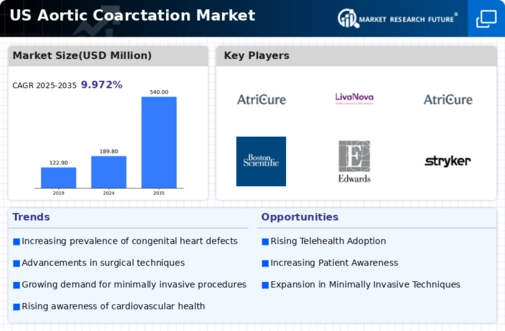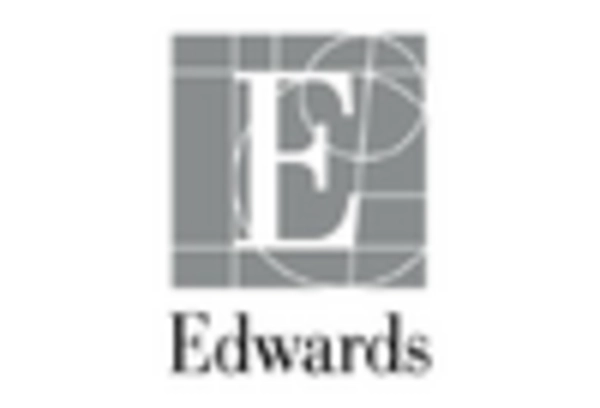Advancements in Surgical Techniques
Innovations in surgical techniques are significantly impacting the aortic coarctation market. Minimally invasive procedures, such as catheter-based interventions, have gained traction, offering patients reduced recovery times and lower complication rates. The introduction of advanced imaging technologies, such as 3D echocardiography, enhances preoperative planning and intraoperative guidance, thereby improving surgical outcomes. As these techniques become more widely adopted, the market is likely to see an increase in the number of procedures performed. Furthermore, the potential for improved patient outcomes may lead to greater acceptance of surgical interventions, thereby driving growth in the aortic coarctation market.
Rising Incidence of Aortic Coarctation
The aortic coarctation market is experiencing growth due to the increasing incidence of this congenital heart defect in the United States. Recent data indicates that approximately 4 in 10,000 live births are affected by aortic coarctation, leading to a heightened demand for diagnostic and therapeutic interventions. As awareness of this condition grows among healthcare providers and parents, the market is likely to expand. The need for effective treatment options, including surgical and non-surgical methods, is becoming more pronounced. This trend suggests that the aortic coarctation market will continue to evolve, driven by the necessity to address the needs of a growing patient population.
Growing Investment in Pediatric Cardiology
Investment in pediatric cardiology is a crucial driver for the aortic coarctation market. With a focus on improving healthcare infrastructure and access to specialized care, hospitals and healthcare systems are allocating more resources to pediatric cardiology departments. This trend is reflected in the increasing number of pediatric cardiologists and the establishment of dedicated centers for congenital heart defects. As a result, the availability of comprehensive care for patients with aortic coarctation is likely to improve, leading to better diagnosis and treatment options. The financial commitment to pediatric cardiology may enhance the overall landscape of the aortic coarctation market.
Increased Research and Development Activities
The aortic coarctation market is benefiting from heightened research and development activities aimed at understanding the underlying mechanisms of this condition. Ongoing studies are exploring genetic factors, potential biomarkers, and novel therapeutic approaches. This influx of research is likely to lead to the development of innovative treatment options, including targeted therapies and advanced medical devices. As new findings emerge, they may influence clinical practices and guidelines, ultimately shaping the future of the aortic coarctation market. The commitment to research underscores the importance of addressing this congenital condition and improving patient outcomes.
Enhanced Collaboration Among Healthcare Stakeholders
Collaboration among healthcare stakeholders is emerging as a vital driver for the aortic coarctation market. Partnerships between hospitals, research institutions, and pharmaceutical companies are fostering innovation and improving patient care. These collaborations facilitate the sharing of knowledge, resources, and best practices, which can lead to the development of more effective treatment protocols. Additionally, joint initiatives aimed at raising awareness about aortic coarctation may contribute to earlier diagnosis and intervention. As stakeholders work together to address the challenges associated with this condition, the aortic coarctation market is likely to benefit from improved outcomes and increased access to care.

















Leave a Comment